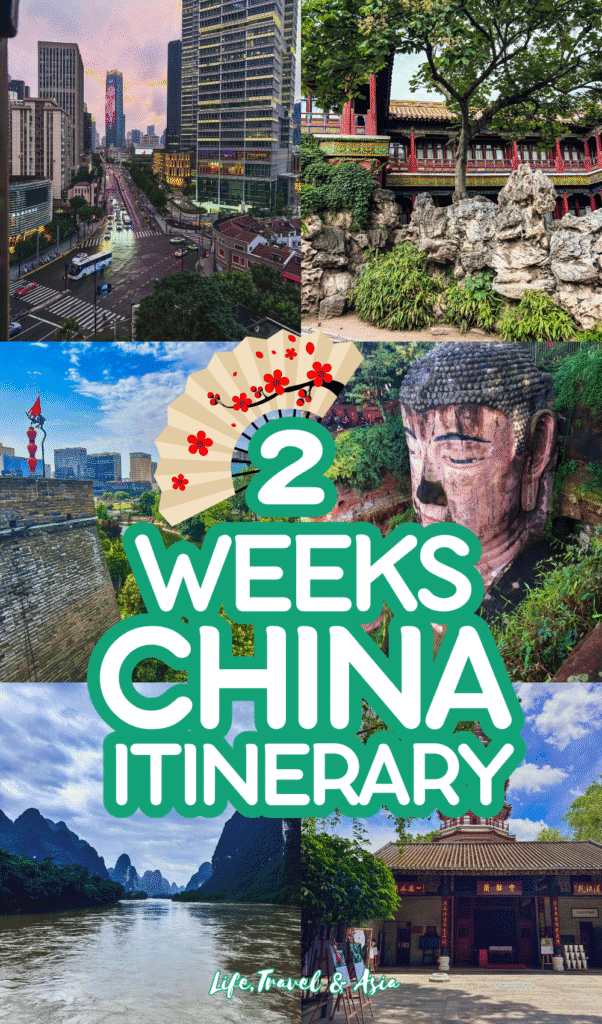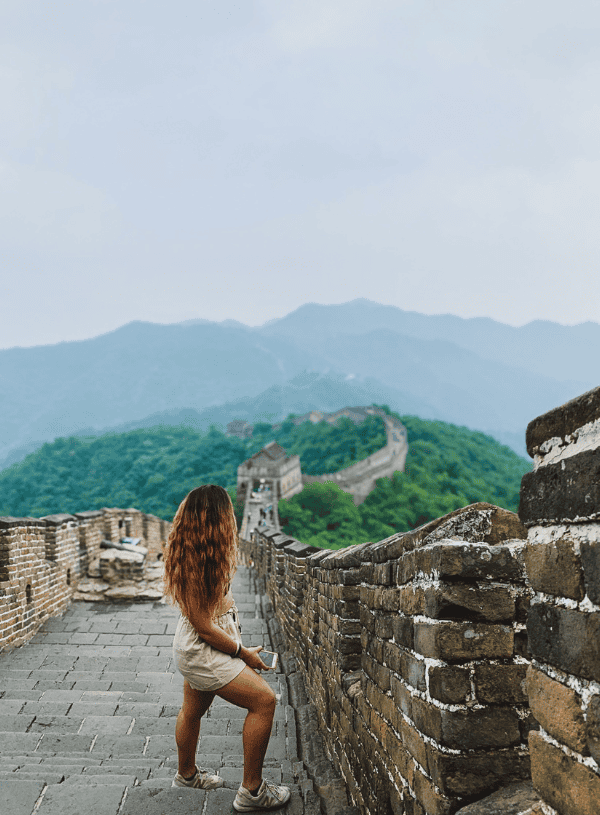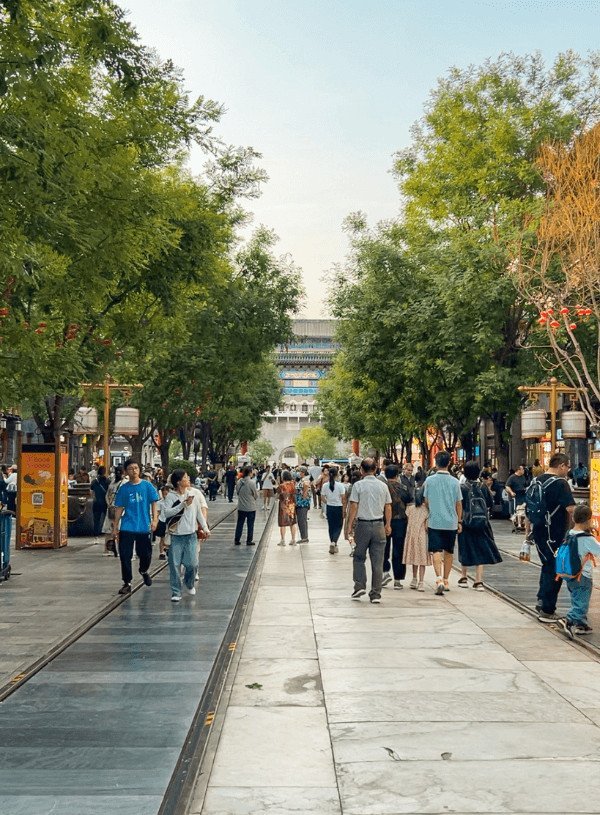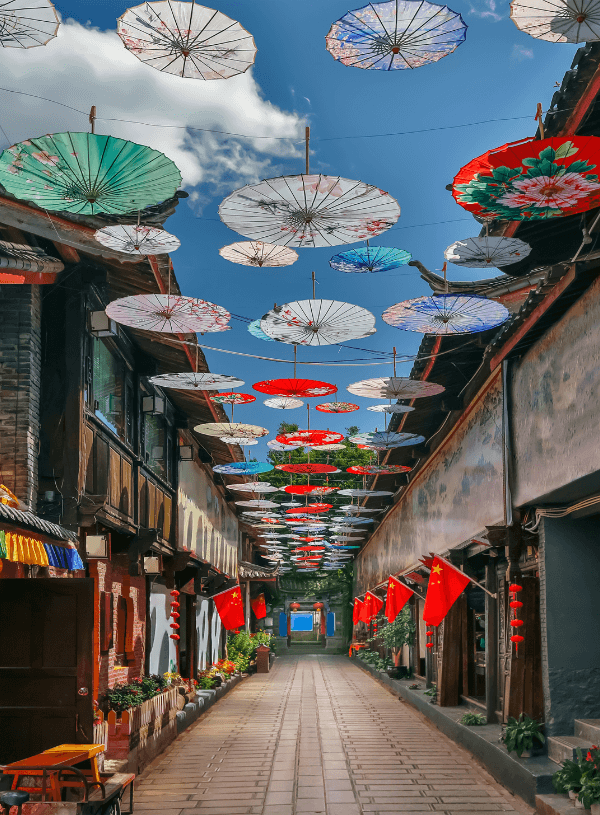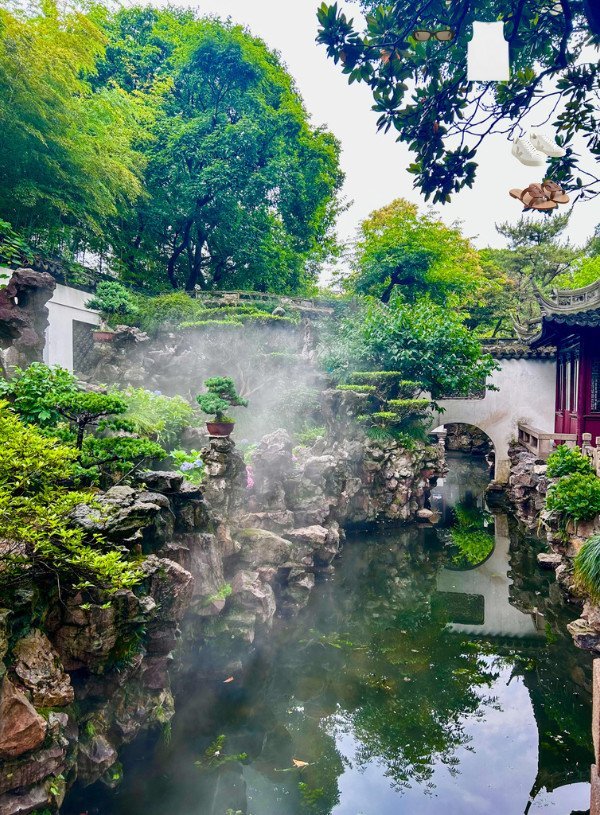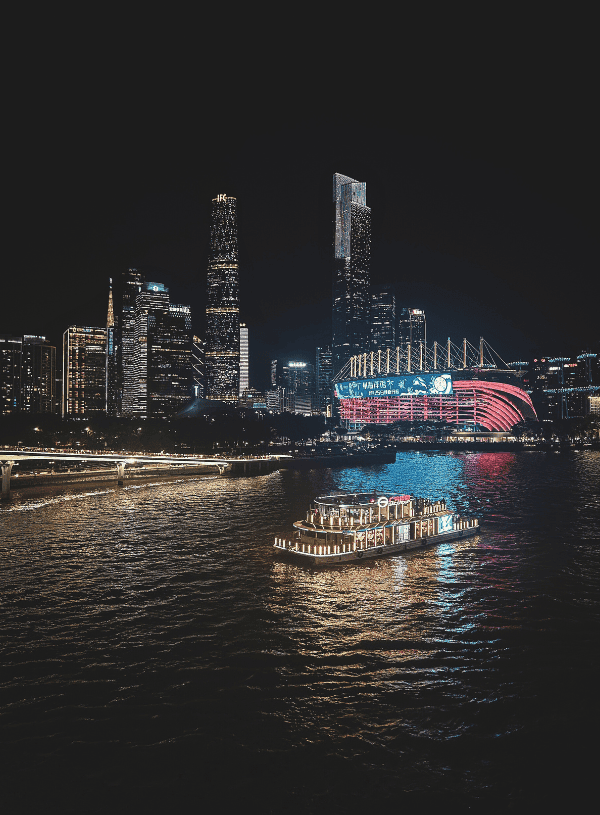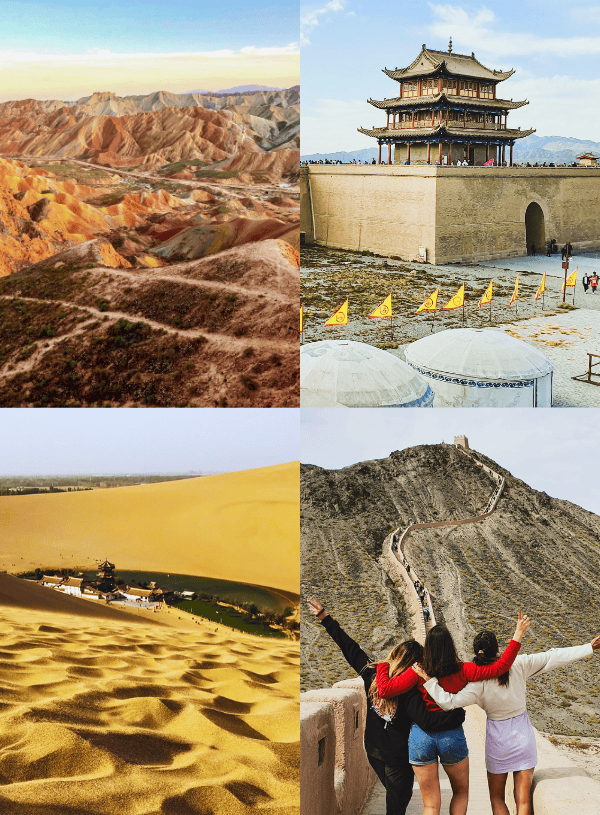Last Updated on June 16, 2025
I know… planning your China travel itinerary can feel like trying to build a complex puzzle. There are so many things to see and do, and never quite enough time. China is huge, and on a first visit, you’ll have to make some tough choices—otherwise, you risk trying to fit in too much and not really enjoying your trip.
Having lived in China for over a year and traveled extensively through the country, I believe the perfect 2 week China itinerary creates a balance between big-city life, a deep dive into ancient history, and the unbelievable nature China has to offer.
In this blog post, I’ll walk you through what I consider the best 2-week China tour for first-timers. If you’re not into certain stops, I’ve also included swap-out options so you can create your dream trip to. Ready to plan?
This blog post is quite long. Make sure to use the Table of Contents below to navigate it.
This article may contain affiliate links. This means that if you purchase through one of the links, I may be paid a small commission at no extra cost to you. Thank you for supporting the blog, allowing me to share meaningful travel experiences with you.
Don’t have time now?📌 Save it for later!

Planning Your Trip
1. Key Things to Know
2. Landing in China & Airlines
Most direct or international flights to China land in Shanghai (Pudong or Hongqiao), Beijing, or Guangzhou. These airports are great for first-timers as staff are used to tourists, and it’s usually easier to navigate arrival procedures like withdrawing cash or buying an eSIM. Plus, Shanghai, Beijing, and Guangzhou are some of the country’s most visited cities with plenty of expats, so your initial culture shock might be a bit softer.
If you’re wondering whether to fly with a Chinese or an international airline, I’ve always chosen Chinese airlines and never had any delays or major issues. Below are some of the highest-rated Chinese airlines. I’ve flown with Hainan Airlines, China Eastern, and China Southern—all three felt reliable and comfortable.
• Air China (international & domestic)
• China Eastern Airlines (international)
• China Southern Airlines (based in Guangzhou)
• Hainan Airlines (mainly Beijing and Shenzhen routes)
3. Getting From The Airport to Your Accommodation
As soon as you land and head for the exit, you’ll be approached by well-dressed guys offering you a “ride”—just say no.
Instead, look for the official taxi signs near the exit and follow them. Have your hotel or guesthouse address printed (in Chinese characters) or clearly written on a piece of paper, and show it to the driver. Before you pull away, make sure the meter is on.
4. Booking Accommodations
To book stays in China, I usually use Trip.com or Booking.com—both work great. Just be sure to check the most recent reviews and message the property before you arrive to avoid any surprises.
In some areas, places can close unexpectedly for renovations, and a few smaller hostels or guesthouses might not accept foreign passports. So double-check availability and policies before you land.
Below are some hotels I’ve stayed at and really liked during my recent trip to China:
- Shanghai: Hotel Ocean — hands down the best international breakfast I’ve found!
- Beijing: Yiting Zhenshe Hotel — a perfect spot right on Qianmen Street.
- Xi’an: MCSRH Hotel — brand new, opened in 2024.
- Guilin: Lijiang Waterfall Hotel — amazing views of the Sun & Moon Pagodas.
- Guangzhou: Paco Hotel— comfy and convenient.
5. How To Get Around Between Chinese Cities
To get around in China, you’ve got two main options: high-speed trains or domestic flights. Which you choose depends on a few factors—distance, price, and how much time you’re willing to spend on transport.
From my experience, though, time on a comfy train can actually be a great chance to catch up on some sleep. To book your flights or train tickets in China, you can use Trip.com. Make sure to book train tickets in advance, because doing it at the train station is a real nightmare.
High-Speed Train
The easiest way to get around China is by high-speed train. They’re fast, comfy, and reasonably priced—though, it depends on how far you’re going.
High-speed train stations are usually in or near city centers, so you can save time and spend it sightseeing. Personally, I think high-speed trains are perfect for trips up to six or seven hours.
Once you consider getting to the airport early, passing through security, and transfers, a train often takes about the same time as a flight. Plus, you get to relax or catch up on sleep along the way.
I’ve never personally taken a long-distance overnight train, but if you’re looking to save some cash and don’t mind missing a bit of sleep, they’re definitely worth considering.
Internal Flights
Internal flights are a great option when you need to cover longer distances and don’t want to spend a lot of time getting there.
The downside is that you’ll have to arrive early, go through check-in and security, and check bags, which can get pricey. Plus, if the weather turns bad, delays become much more likely.
6. How To Get Around In Chinese Cities
Subway
The subway is the easiest and most efficient way to travel around Chinese cities. It’s safe, extensive, and reaches just about every corner of town.
Below are a few handy tips to help you navigate the Chinese subway system:
- Bag Scan Everywhere: Be ready to place your bag through a detector at every entrance.
- English on Vending Machines: The vending machines have an English language option.
- Ticket Price: Select the number of tickets and the fare for your trip. You can easily find the fare in your Metro app or even by using Maps on your iPhone. Type your destination and starting point, choose “directions by subway,” and voilà—your fare will appear along your route.
- Alipay for Payment: Make sure you have Alipay installed on your phone. To pay, scan the QR code on the ticket vending machine.
- Bilingual Signage: All subway stops are labeled in Chinese characters and their alphabetic transcription (pinyin), so you’ll always know where you are.
Taxi
Taxis can be a convenient way to get around cities in China, especially when heading from airports or train stations to your accommodation.
While they’re not always the best option for daily use—thanks to the famous traffic in many Chinese cities—they can still be a lifesaver when you must reach remote locations. Below are some tips on how to navigate the taxi systems successfully:
- Stick to licensed taxis: Always ensure you’re getting into a legitimate taxi with proper signage and that it turns on the meter.
- Avoid crowded areas: Avoid hunting for taxis in super busy spots. You’ll end up fighting for one with tons of other people.
- Have your destination written down: Chinese drivers don’t speak English, so it’s always helpful to have your address in Chinese characters for them to read.
- Carry some cash: While most drivers accept Alipay or WeChat Pay, having cash is always a good idea just in case your app or connection fails.
Bus
Buses are cheaper than taxis if you need to reach remote areas. They are also the way to go if your budget is tight and you have an adventurous soul (considering some may be actually randomly cancelled if you’re visiting in off-peak travel season)
See below some tips to navigate the bus system in China and make sure you arrive where you need to be:
- Use apps to find your route: Tools like Rome2Rio, Google Maps, or Apple Maps can help determine which bus to take. However, double-checking your route is always a good idea!
- Get confirmation from locals: Ask your hotel or hostel staff to confirm whether a particular bus goes to your destination. It’s always better to double-check.
- Ask the driver: When you’re at the bus station, show your destination (written in Chinese) to the driver and make sure you’re boarding correctly. Triple-Check is the way!
Bicycle Rides
Bicycles are a fun way to travel those short distances while exploring the streets. Locals love them! You’ll find dedicated bike lanes available in many cities.
The payment process is straightforward. All you need to do is have Alipay installed on your phone. Scan the QR code when you’re done riding, and voilà—your payment will be processed at the end of your journey.
If you’re looking for more details on traveling to China, my comprehensive travel guide could be exactly what you need. You’ll find everything from visa requirements and the best times to travel to tips on language, etiquette, and so much more.
2 Week China Itinerary For First-Timers
This itinerary is the one I took in the summer of 2024. It brought me from Shanghai—one of my favorite cities in China—to Guangzhou, a place I’d never visited, but that turned out to be a fantastic surprise. Along the way, I stopped in Beijing, Xi’an, and Guilin.
Like I said, if you want to soak up each city’s vibe, two weeks is just enough—fitting in five or six places already makes for a packed trip. But if you’ve got more time, I’ll share a few ideas for exploring some amazing natural spots in central China from Xi’an. That’s what I would’ve done if I’d had extra days. And if you find my itinerary a bit too busy, you can skip one stop and enjoy more time elsewhere.
I personally traveled by train for most of the journey, except for Xi’an to Guilin, which was quite a long route (plus it got delayed by two hours because of bad weather).
Here’s a quick rundown of the itinerary:
• Shanghai (Days 1–3) – includes a day trip to Zhujiajiao Water Town
• Beijing (Days 4–6) – includes a visit to the Great Wall of China
• Xi’an (Days 7–8) – includes a stop at the Terracotta Warriors
• Chengdu (Days 9–10) – I didn’t make it there this time, but it’s easy to reach from Xi’an
• Guilin (Days 11–13)
• Guangzhou (Days 14–15)
Shanghai: Old vs. New, City Temples & Big City Life
Tickets & Tours in Shanghai
I wouldn’t define Shanghai as one of those cities with “a lot to see,” per se. It’s one of the Chinese cities with fewer official “AAAAA” tourist attractions (only the Pearl Tower). However, it’s the kind of place where you can wander around and never get bored, especially in Jing’an and Huangpu, two of the most traditional districts.
You can people-watch, stroll along the Bund, try plenty of street foods, and soak up its restless, unparalleled energy.

I also don’t think any first trip to China would be complete without a stop in Shanghai. It sums up modern China perfectly—extremely futuristic yet still deeply connected to its ancient traditions, making it an ideal start to your itinerary.
Getting here is easy too, with two international airports, and the culture shock can be a bit softer since the city is used to travelers. Among the must-dos, I recommend plenty of aimless (but not so aimless!) wandering, visiting a few temples, stopping by a traditional Chinese garden, and, of course, tasting all the Xiaolongbao you can find.
Day 1: “Feel” The Energy of Shanghai
Laoximen & Xintiandi
Depending on when your flight lands and how much time you need to recharge, that aimless wandering is perfect for your first day in Shanghai. That’s exactly what I did, after not having seen China’s financial hub for over four years.
Of course, Shanghai is one of the most modern cities in China, but some older, untouched districts still survive, though probably not for much longer. One of them is Laoximen.
In 2017, the communities that had lived there for decades were relocated to other parts of the city to make space for new developments. Since then, the area has mostly emptied out, but it still features the traditional Shikumen architecture that was once so typical of old Shanghai.
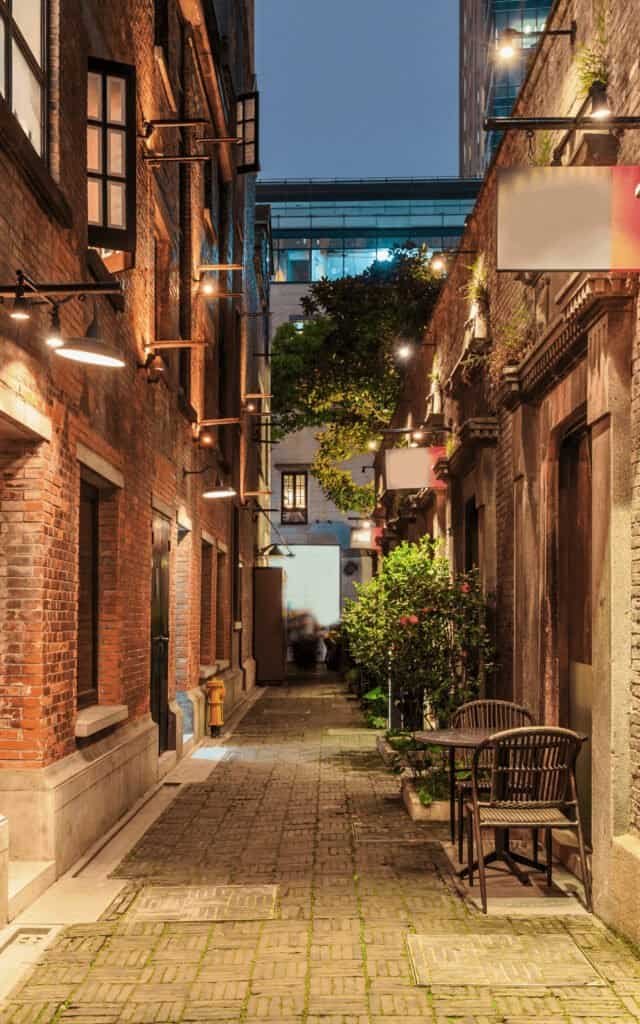

Using Laoximen Station as a reference point on your map—east of South Xizang Road—puts you near the modern commercial district of Xintiandi on the opposite side of the same road. Although these two areas are only a few streets apart, they feel like completely different cities in entirely different eras.
Xintiandi is a bustling commercial zone with modern shops, restaurants, and cafés housed in renovated Shikumen-style buildings. Naturally, the vibe here couldn’t be more different. You’ll find stylish locals (Shanghaians, I suppose) dining in fancy restaurants and shopping for the latest trends.
By strolling from Laoximen to Xintiandi, you can experience the old vs. new contrast I mentioned earlier!
Yuyuan Old Street
If you have time on your first day, you might want to explore the area around Yuyuan Garden. It is quite a sight, especially in the evenings, without the usual daytime crowds. It’s also a perfect spot to grab something local for dinner.
From Xintiandi, you can hop on Subway Line 14 at South Huangpi Road Station and ride it to Yuyuan Garden Station.


The Yuyuan area sits right in the center of Shanghai’s old district, and you’ll find that classic Chinese vibe that makes it one of the city’s most popular tourist spots.
The buildings—mainly restaurants and quirky souvenir shops—have been restored and painted in bright, traditional red, with sloping roofs. You can sense the modern twist in the renovations. However, the small artificial lake surrounded by picturesque bridges still creates a charming backdrop for a first authentic Chinese dinner in Shanghai.
Day 2: Gardens, Temples & Big City Life
The first full day in Shanghai is perfect for sightseeing. As I mentioned, there aren’t that many historical monuments here—aside from a few Buddhist temples and the Yu Garden—so you can easily pack these visits into a single day.
Yu Garden
I recommend making Yu Garden your first morning stop since it’s one of the most popular places in town for locals and international visitors. It’s a fantastic example of a classical Chinese garden, especially if you haven’t been to Suzhou yet—so it’s a great chance to get a taste of that style.
The garden is extremely charming, with meticulously maintained greenery, rockeries, pavilions, stone bridges, and ponds. However, the crowds can significantly detract from the experience, so going early in the morning, ideally on a weekday during the off-peak season, will give you the best impression. Also, make sure to purchase your tickets in advance to avoid wasting time in queues.


I’ve visited twice—once during the Golden Week national holiday and once at the end of June—so, honestly, I might’ve never seen it at its absolute best. Still, both visits were great, and the garden offered a wonderful escape from the city.
Buddhist Temples: Jade Buddha, Long Hua, Jing’an
I have to be honest: after visiting truly suggestive Buddhist sites carved into mountain cliffs, where the natural surroundings add a whole other atmosphere (like the Mati Temple in Gansu), I’m no longer as fascinated by what I call “city temples.”
There’s just such a strong contrast between the spiritual and calming energy you feel inside temple grounds and the hectic, anything-but-spiritual buzz of the outside world. Plus, the natural scenery surrounding some of these mountain-perched Buddhist sites can’t compare to Shanghai’s noisy, polluted streets.


But on the other hand, I truly believe that’s their whole purpose: to offer a spiritual escape from materialistic life. For this reason—and because they give you a different perspective of China than you might expect—you should definitely visit at least one.
The Jade Buddha Temple was founded in 1882 mainly to house two jade Buddha statues brought from Myanmar by sea: a 1.95-meter-tall sitting Buddha and a smaller reclining Buddha symbolizing the Buddha’s death.
Long Hua Temple is recognizable by its pagoda (today only one remains, though there were 13 in the past), and its golden Buddha statues, which are truly mesmerizing.

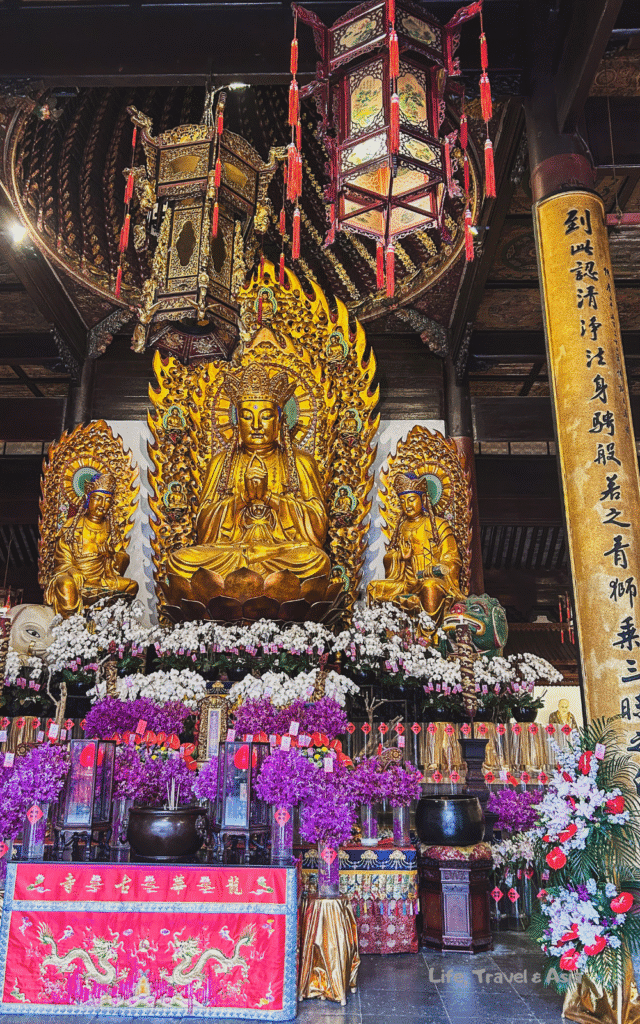
Finally, Jing’an Temple is right in the heart of one of the busiest streets, Nanjing Road, where you can really feel the contrast between the spiritual vibe inside and the city’s buzz outside.
If I had to choose, I’d visit the Jade Buddha Temple and Jing’an Temple because they’re easier to get to (Longhua is a bit farther away). But honestly, all three are worth seeing. Here, you can purchase tickets directly on site; no need to book in advance.
Tianzi Fang
The district of Tianzi Fang was one of the best surprises during my stay in Shanghai. I hadn’t been there before, but if you love Shikumen-style alleys with a sprinkle of hippie, artistic vibes, that’s precisely the place.
Wandering around these alleys, you’ll definitely find souvenir shops, but also modern cafés with trendy customers, artistic studios, and boutiques selling all kinds of quirky finds—from upscale teas to kids’ shops—even Chinese-style chiringuitos with high chairs and a super international crowd. And locals actually live here!


It’s the perfect spot for a late-afternoon beer or coffee, whether hanging out with friends or on your own. It’s also the kind of place where you might easily end up having a conversation with someone new. Definitely a must-visit!
The Bund
The evening of your second day in Shanghai is finally time to head to the Bund (be sure to go after dinner since there aren’t many local spots there) and take a stroll while admiring the heritage buildings from the Concession era on one side of the road, and the Pudong district with its iconic Shanghai skyline on the other side of the Huangpu River. Here’s where you truly feel the electric, restless soul of Shanghai.
In my opinion, the best way to enjoy these views is by taking a river cruise on the Huangpu. This is the kind of moment when you can take a breath, relax, and start realizing where you are and what a vibrant, alive city Shanghai is, and you’re part of it. Here is the tour I took.
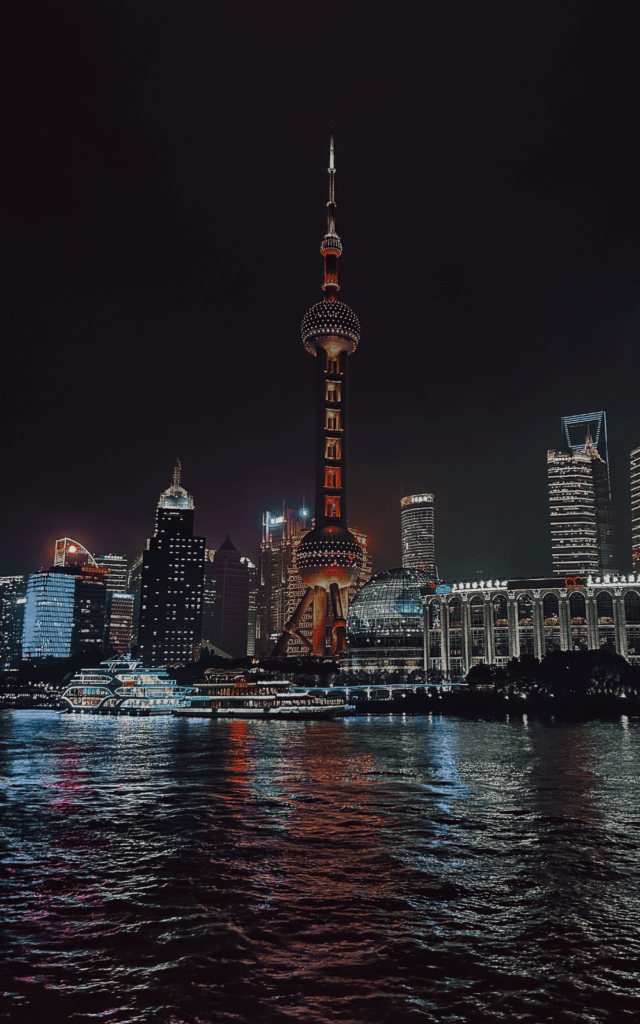

There are plenty of other ways to experience the Bund area around sunset, too: you can head up one of the skyscrapers for a truly exclusive view of the city, have dinner at the Pearl Tower restaurant, or even cross the river and wander through the surreal modernity of Pudong.
Day 3: Zhujiajiao Water Town
On the third day of my stay, we headed to the nearby Zhujiajiao Water Town, which is actually in Shanghai (even though it’s more than an hour away by subway) but feels worlds apart. Even though it’s touristy, visiting Zhujiajiao means stepping into a much slower pace of life, where walking (and electric scooters) is the only way to get around.
Zhujiajiao is a typical water town, filled with narrow alleys, stone bridges, winding canals, and all kinds of shops (even the ones selling insects). Here, you’ll also find a few interesting sights you can visit with a Water Town ticket that you can purchase on site.
Visiting Zhujiajiao without a guide is totally doable, just head to the dedicated Zhujiajiao day trip post for all the details on planning your trip and ticketing options. There are also plenty of organized tours from Shanghai, which can save you the hassle of DIY planning.
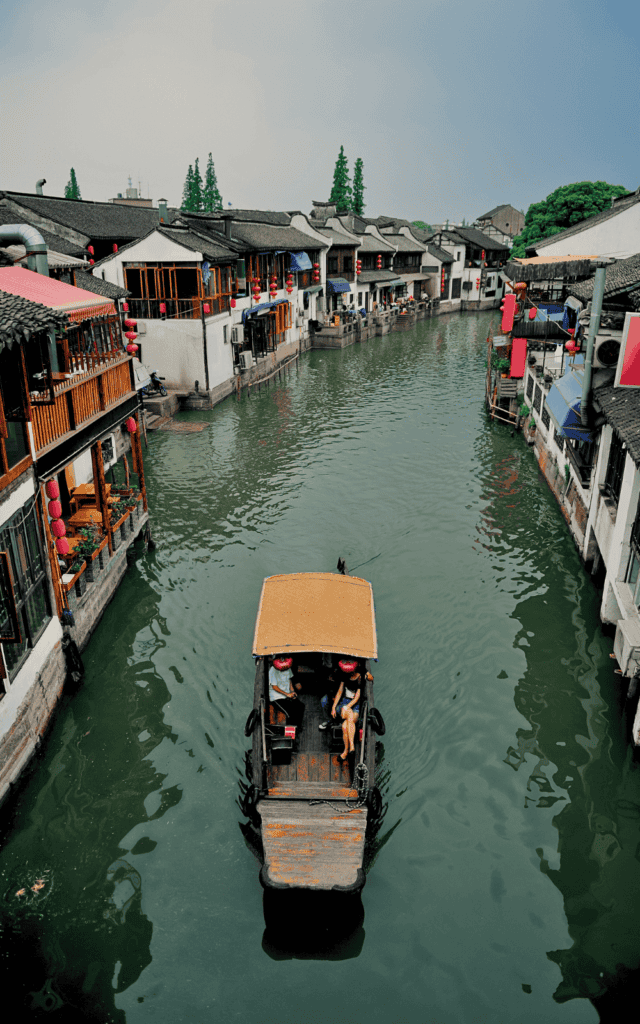
After visiting Zhujiajiao, we headed back to downtown Shanghai to catch the train to our next stop: Beijing. I usually suggest booking a late-afternoon train, so you can arrive in the new city, head straight to your hotel, rest, and wake up fresh and ready to explore.
If you’re looking for more details—like where to stay or how to get around in Shanghai—take a look at my Shanghai travel guide.
Beijing: History, Temples & The Great Wall
From the not-so-historical Shanghai to the monument-rich Chinese capital, Beijing. But don’t make the mistake of thinking Beijing is just home to a bunch of UNESCO World Heritage Sites.
Actually, it combines the best of both worlds: traditional China, with its customs, the charming Hutong alleys, and the vibrant vibe of Gulou Street, and modern city life in districts like Sanlitun and Wangfujing.
Beijing is also the perfect starting point for day trips to many sections of the Great Wall. Honestly, it’s impossible to get bored here, and it’s another city where even five days might not be enough to see it all. I made the most of my three days, but to be completely honest, I’d go back to Beijing again and again (not in the Summer).
Tickets & Tours in Beijing
Day 4: Exploration Around The Forbidden City
Beijing Hutongs
For me, the Qianmen area is the best place to stay in Beijing. Not just because there are plenty of local restaurants and even a Starbucks (in case you’re not quite ready to try a Jian Bing, the typical Chinese breakfast, first thing in the morning), but also because it’s such a lively neighborhood. You’ll find all kinds of shops, souvenirs, textiles, tea… you name it, and lots of smaller, narrow alleys branching off the main street that are perfect to explore.


This area really showcases the cultural and architectural heritage of ancient China. If you check your map, you’ll notice a lot of streets called Hutongs. These are networks of small, often intricate alleyways that make up the historic districts of Chinese cities. Hutongs used to host the typical Chinese family compounds called Siheyuan.
Around Qianmen, you’ll find some of the most characteristic ones: Liulichang Cultural Street, Dashila’r, Tan’er, and Tiaozhou Hutongs are all worth a stroll, especially if you’re looking to experience a quieter, more traditional vibe compared to the busy Qianmen Street.
Tiananmen Square & Mao’s Mausoleum
Within walking distance from Qianmen Street, just to the north, you’ll find Tiananmen Square, right in the heart of the city. Inside the square, you’ll see some of China’s most significant landmarks, like the Monument to the People’s Heroes, the Great Hall of the People, the National Museum of China, and course, the most iconic (also thanks to the huge portrait of him): Mao Zedong’s Mausoleum, which has pretty much become the symbol of Tiananmen Square.

All these monuments are free to visit, including the museum. But keep in mind the time of day and period of the year you’re visiting—you might end up stuck in long queues. Just so you know, entering Tiananmen Square requires a passport and bag security check, and depending on the season, this can take a while (in June this year, it was up to three or four hours).
My honest take? Tiananmen Square is huge, but not exactly beautiful. Most people go for its historical significance. If you’re not particularly interested in that, feel free to skip it…you’re really not missing much.
The Forbidden City
Skipping Tiananmen Square might be smart—it’ll save you time for a much more interesting visit to the true symbol of Beijing (and a UNESCO World Heritage Site): the Forbidden City. Even though it’s not my personal favorite in Beijing, it’s definitely one of those must-see places.

This massive complex (around 980 buildings and over 8,000 rooms) was the imperial palace during the Ming and Qing dynasties. It served as the emperor’s residence, ceremonial site, and political center for nearly five centuries.
If you want to experience the best of traditional Chinese architecture, this is the place. The vibrant colors, intricate carvings, sloped roofs, and the beautifully maintained Imperial Garden at the back—all of it feels like a deep dive into Chinese art and history.

Normally, I wouldn’t recommend tours if you can explore on your own, but this is one exception.
A local guide can make the difference by sharing the stories, history, and small details you might miss, while also helping you navigate the most important spots without wasting time. It’ll make your visit more meaningful and way more enjoyable. This is one of the most highly rated English-speaking tours.
Ah… almost forgot! After you visit the Forbidden City, make sure to head over to Jingshan Park. It’s a bit of a climb after walking through the whole complex, but totally worth it. From up there, you’ll get the best panoramic view over the sloped roofs of the Forbidden City—and one last chance to take in just how massive it is (and how many steps you’ve taken to get up there!).
Dinner at Gulou Street
For some reason, I had completely forgotten about Gulou East Street in Beijing—but as soon as I arrived there during my last visit, everything came rushing back from my first trip back in 2018. This area, around the Drum Tower, is worth a stop, especially at night when it’s all lit up.
This is the place to be in the evenings (and, unfortunately, I’m not the only one who thinks so!). You’ll find those iconic hutong streets again, lined with all kinds of souvenir shops, boutique stores, and a super lively night market where you can try some authentic Beijing street food.
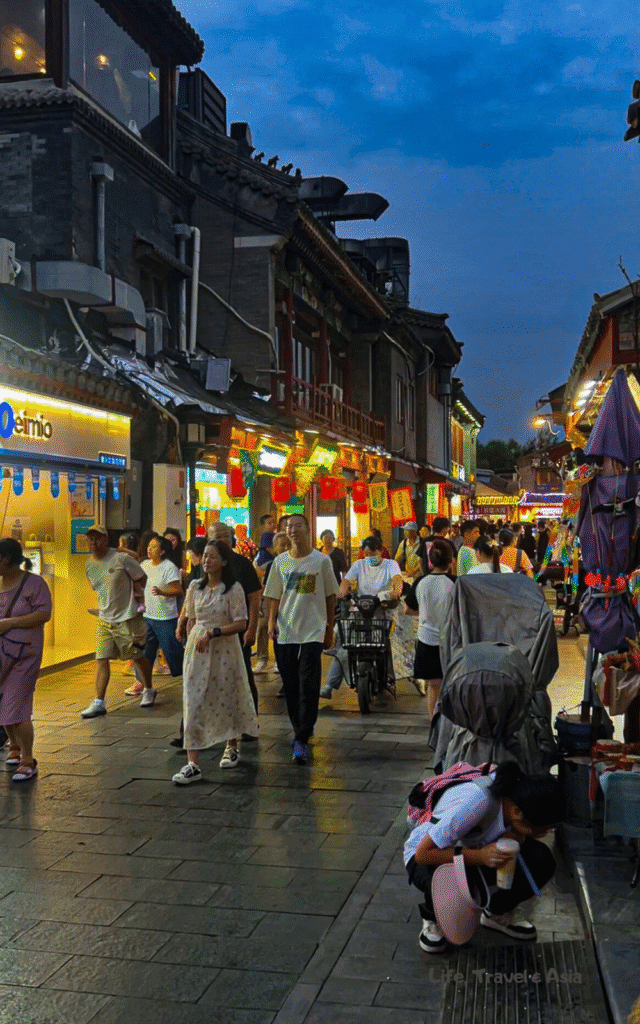
After dinner, it’s perfect for bar hopping. There are tons of chill, hippie-style bars with local live bands, and even an artificial lake where people rent boats for a nighttime ride. We ended up having dinner at a random hotpot spot near the lake—and honestly, it turned out to be the most local experience of the whole trip.
Day 5: Summer Palace & Temples
The Summer Palace
Here it is: my absolute favorite spot in Beijing (and yep, another UNESCO World Heritage Site). Ever since my first visit back in 2018, I’ve always been drawn to the elegance and sense of peace created by the blend of the building’s vibrant colors and the surrounding greenery.
It’s a bit farther out than the other main attractions—understandably so, since this was the summer residence of the Emperors, meant to offer a break from the Beijing heat.
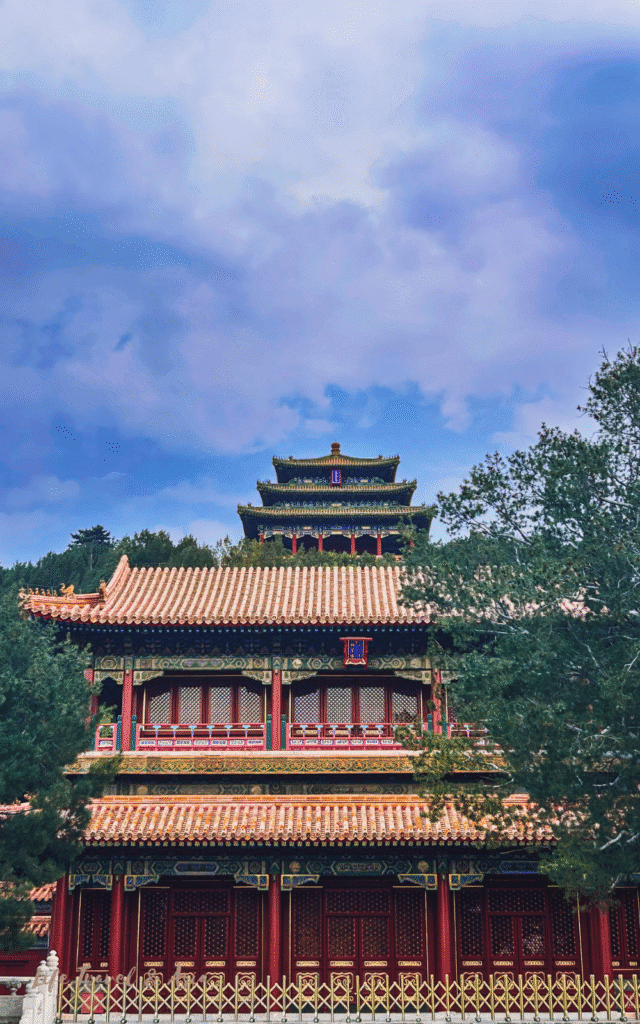

While newbies may expect a palace, this is an extensive park area with many different buildings and sights to explore, in front of Kunming Lake. It was conceived during the Qing dynasty and then rebuilt several times due to war damage.
As for the Forbidden City, I highly suggest a guided experience to explore the Summer Palace (maybe combined with the Temple of Heaven). While you could basically get to the site in the morning and still not be done by late afternoon, a guide can tell you interesting anecdotes and help you head straight to the interesting parts of the site, making your visit much more interesting.
Temple of Heaven
In second place on my list of Beijing’s top sights is the Temple of Heaven. This Confucian temple was visited by the emperors of the Ming and Qing dynasties for annual ceremonies to pray to Heaven for a good harvest.
One of my dreams is to visit it during closed hours to really soak in its energy—but even with the crowds, it’s still a sight to behold. What strikes the eye most is the contrast between the deep colors of the main circular building (The Hall of Prayer for Good Harvests) and the three-tiered marble base it stands on.

In Confucian symbolism, Earth is represented by a square and Heaven by a circle, and many features of the complex reflect this connection between Heaven and Earth.
I’ve never visited this temple with a guide, but honestly, I think it’s worth it. There’s so much symbolism and spiritual meaning built into the architecture that a guided experience can deepen your understanding—and leave you with a lasting impression of this incredibly special place.
Lama Temple
The Lama Temple (also known as Yonghe Temple) is one of those rare places in Beijing where everything seems to slow down. It’s colorful, peaceful, and full of spiritual energy.
Once an imperial residence during the Qing dynasty, it was turned into a Tibetan Buddhist temple in the 18th century and has been a major spiritual site ever since. Today, it’s considered the most significant Tibetan Buddhist temple outside of Tibet.

Make sure not to miss the giant Maitreya Buddha housed in the last hall. Standing at 18 meters tall and carved from a single sandalwood tree, it’s seriously impressive!
Wangfujin & Sanlitun
If you’re into Chinese food (who isn’t?), Wangfujing is basically heaven for food lovers. You can find anything—from classic Chinese dishes to cool modern spots. If you’re looking for a place to try the Peking Duck, don’t leave without trying the duck at Quanjude.
If you’re up for something more hands-on, Haidilao Hot Pot is a whole experience. It’s always time for a hotpot even if you’re not in Sichuan.
After dinner, Sanlitun is where the city comes alive. It’s got chill bars, loud clubs and rooftop drinks. Last time I was in Beijing, we were at the Martini rooftop. The vibe was great, with plenty of expats and locals, great music, and good drinks.
Day 6: Day Trip to The Great Wall
No trip to Beijing is complete without hiking a section of the Great Wall! Once you’ve got that settled, the next step is choosing which section to visit.
Here’s the truth: the easiest ones to reach are also the most crowded. The wilder, untouched parts are a real adventure—and you’ll definitely need a guide, especially if you don’t speak Chinese. Getting there is already part of the experience, even before the actual hike begins.

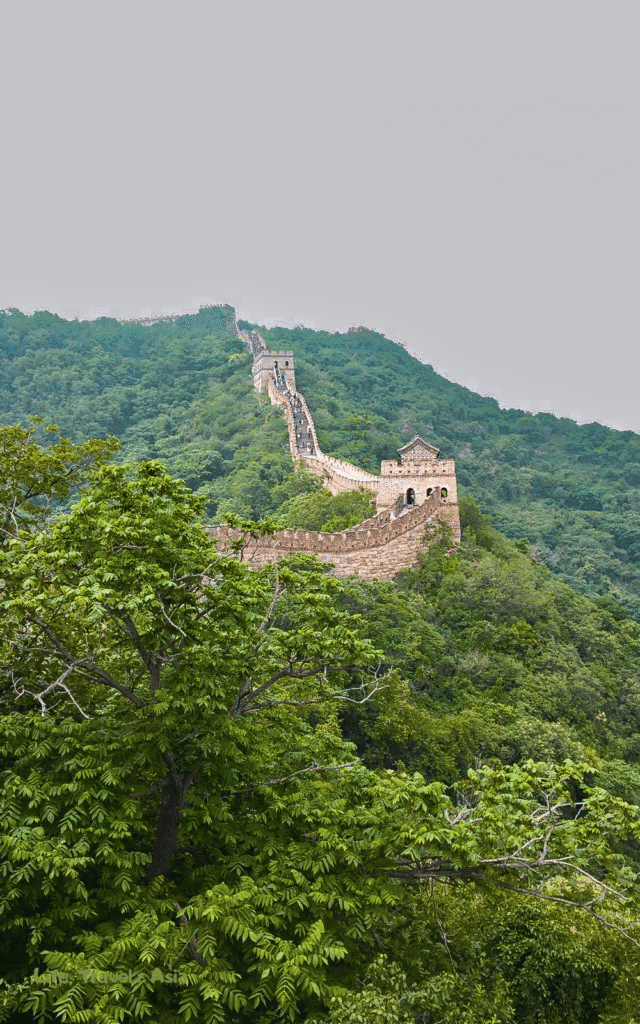
Mutianyu is the perfect middle ground: not as crowded as Badaling, but still manageable as a DIY day trip. In this blog post, I’ve included all the details you need to plan it on your own—just bring your adventurous spirit (and be ready to taxi hunt).
If you’d rather skip the hassle and opt for a raw, less touristy experience, I highly recommend Jiankou. It’s the only fully wild section of the Wall, officially closed to tourists, so you’ll need a guide—but it’s absolutely worth it.
After returning from our day trip, we had a good night’s rest and got up early the next morning, ready to catch our high-speed train. Destination? Xi’an!
If you’re looking for more details—like where to stay or how to get around in Beijing—take a look at my Beijing travel guide.
Xi’an: Warriors, Walls & Ancient Vibes
Keep in mind that whatever I say about Xi’an is influenced by the fact that it’s my home away from home in China, so I’m definitely not impartial… Jokes aside, Xi’an has actually been the favorite stop for some of my travel mates, so it’s safe to say it is the gem I think it is.
Xi’an is tiny compared to Beijing and Shanghai, and visiting it is super easy because all the main sights and most interesting areas are almost entirely within the City Walls.
Speaking of which, the City Walls are the architectural highlight of Xi’an: they’re the largest and best-preserved city walls in all of China.

Xi’an was once the ancient capital of the Chinese Empire during the Tang dynasty and the starting point of the Silk Road.
Crossroads of cultures once, crossroads of cultures forever. One of the most fascinating aspects of the city is the unique blend of Muslim and Chinese influences, especially around the Muslim Street, one of the liveliest areas to explore.
But history doesn’t mean boredom. In Xi’an, nightlife is very much alive, with live music, expat bars, and clubs scattered throughout the city. And let’s not forget the food scene…it’ll definitely keep you well entertained (and well-fed!).
Tickets & Tours in Xi’an
Day 7: Exploration Within the City Walls
Bell Tower
Xi’an doesn’t take days to explore—one full day is enough to see all the main sights within the City Walls. You’ll want to start from the heart of it all: Zhong Lou, which means “Bell Tower” in Chinese.
If you look at a map, you’ll notice that it sits right at the center of the walled city, and it’s also the busiest (and most confusing!) subway station in Xi’an—getting lost here feels like part of the initiation process.

The Bell Tower itself is a stunning architectural example of Ming-style design, and honestly, it’s at its best in the evening, when the whole structure is beautifully lit up.
You can visit it through an underground walkway, but to be honest, the visit is nothing exciting. Inside, there’s a small museum, the original bell, and some daily performances.
My final take is: Walk by during your daytime stroll, skip the visit inside if you’re short on time—but definitely come back at night when the lights turn on. It’s worth it.
Drum Tower & Muslim Street
Just a 5-minute walk west of the Bell Tower is the Drum Tower, another symbol of Xi’an. Like its twin, it’s especially stunning at night when it’s all lit up. You can visit the inside, but again, it’s nothing too exciting.
What is exciting, though, is what lies just behind it: Huimin Jie, or Muslim Street.
This area is the heart of Xi’an’s Muslim community and home to the city’s best street food and most vibrant night market. Once the starting point of the ancient Silk Road, it was filled with travelers, merchants, and explorers—many of whom came from Persia, settled here, and left behind a rich cultural heritage that still thrives today.


The street is home to around 10 mosques, including the Great Mosque (the largest and worth a visit), as well as the City God Temple and a couple of Ming and Tang dynasty gates.
But let’s be real: you’re here for the food. Don’t miss the Rou Jia Mo (Chinese-style hamburger stuffed with juicy meat) and Jia San’s Steamed Buns filled with beef. The Pita Bread Soup is another local classic. My advice is to follow your gut—literally.
Cycling Around The City Wall
The best (though also a bit tiring) way to get a complete overview of Xi’an’s city center, without walking for hours, is by cycling around the City Wall. It’s one of the most popular things to do and gives you a unique perspective on the contrast between the old, traditional buildings inside the wall and the modern skyscrapers and hotels outside of it.

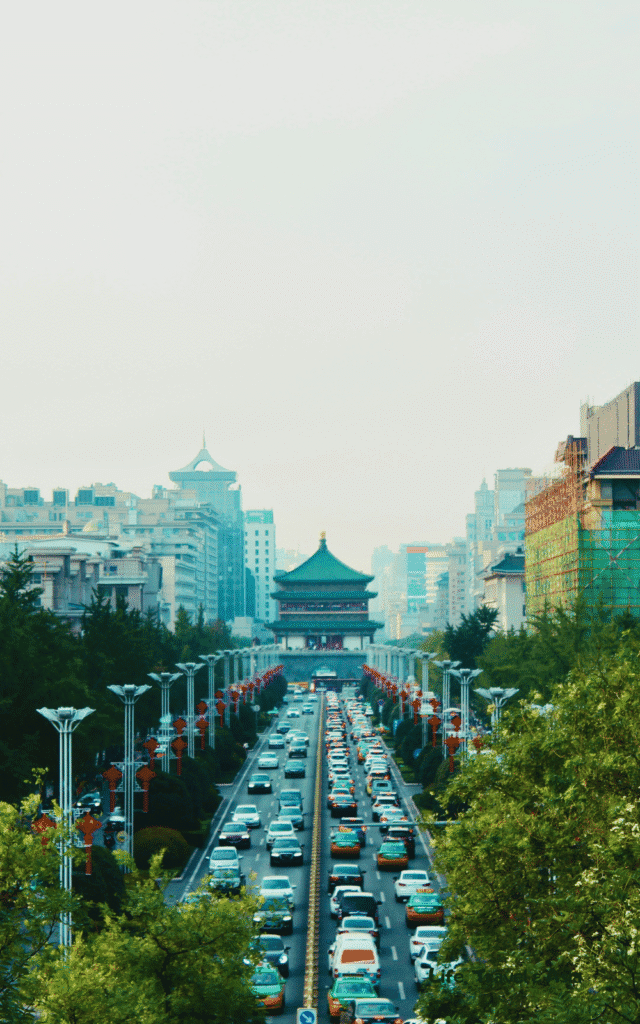
You can access the wall from any of the four main gates and rent a bike at the top. Just keep in mind: around the South Gate, where most people walk, you’ll need to push your bike by hand. You can drop the bike off at any gate when you’re done.
The whole loop is around 14 km long, and I highly recommend taking it in the late afternoon or around sunset. That’s when the gate towers light up beautifully—and it’s cooler, so you’ll sweat a lot less.
Dinner & Evening at Dayanta
Dayanta is another popular area, attracting both tourists and locals. It’s a huge district stretching from the Dayanta subway station to Tang Paradise Park. Honestly, you could spend hours here, but try to go on a weekday night, because the weekend crowds are intense. I’ve rarely seen so many people in one place as I did here in June.
Start your stroll at the Giant Wild Goose Pagoda—maybe even catch the famous fountain show. This area is great for people-watching: you’ll see women in traditional costumes, groups dancing, and live street performances.


On your way to Tang Paradise, stop near Datang Everbright City to grab a bowl of Biang Biang noodles—a Xi’an classic. They’re super wide and thick, and yes, you’ll probably wish you had a knife.
Tang Paradise is a themed cultural park that celebrates the Tang dynasty. While it’s all reconstructed and might feel a bit touristy, the gardens, lake views, and cultural shows make for a relaxing evening and a nice change of scenery from the city wall vibe.
Day 8: Terracotta Warriors or Huashan Hike
If there was something I hadn’t managed to do while living in Xi’an, it was visiting the Terracotta Warriors and hiking Mount Hua. I planned both many times… and then life happened.
I ended up visiting the Terracotta Warriors more out of logistics than desire—I would have much rather spent a day hiking one of China’s sacred Taoist mountains. A day in nature beats a day surrounded by tourists, at least for me.
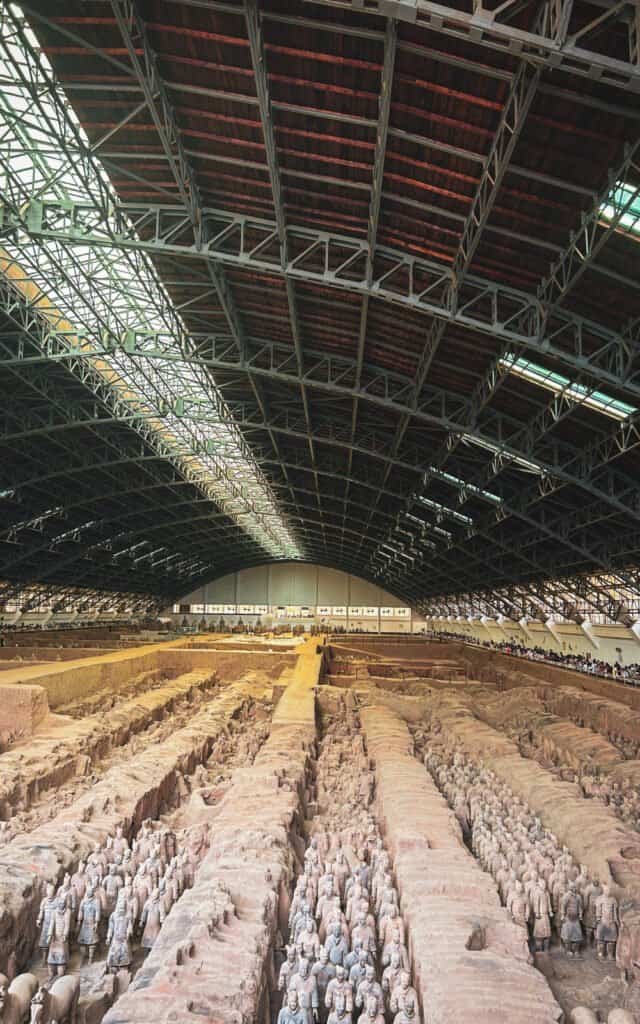
Don’t get me wrong, the Terracotta Army is impressive. The level of detail—the fact that each warrior has unique features—is genuinely mind-blowing. But if you’re anything like me, you’ll probably find more joy in the dramatic mountain views and spiritual energy of Mount Hua.
If you opt for the historical site, I truly believe a guide will enhance your visit. The site is massive, and without some context, it’s easy to miss key details and the fascinating story behind it all.
If you do go for the hike (which I highly recommend), the easiest way is to take a high-speed train from Xi’an North Station to Hua Shan North Station, then hop on a minibus to the mountain entrance. If you want to save time and skip the transfers, you can also book a private car service directly from Xi’an (definitely ideal if you need to catch a train right away and need to carry your luggage with you).
After we visited the Terracotta Army, we headed straight to the airport to catch our flight to Guilin. That said, in this China tour, I do think Chengdu could be an interesting stop. I visited back in 2019, and its laid-back vibe and kind locals still hold a special place in my heart.
If you’re looking for more things to do in Xian or more travel tips (where to stay or how to get around), take a look at my Xian travel guide.
Chengdu: Pandas & Buddhas
I’ve been to Chengdu for the first time back in 2019, and I honestly didn’t expect such a lively yet laid-back vibe. Many expats I met in China chose Chengdu as their base, not only for the more livable feel compared to bigger cities, but also for what it has to offer.
As the capital of Sichuan province, it’s right at the center of a region that hosts some of the most incredible natural sights in China. On top of that, it’s a culture-rich city, known for its teahouses where locals go to relax, the Sichuan Opera — a very unique type of performance — and, of course, its food scene, which attracts people from all over China.

Last but not least, Chengdu is known as the city of pandas, with the Chengdu Research Base of Giant Panda Breeding located just outside the city center, easily reachable by taxi.
Despite being small compared to China’s megacities, Chengdu is definitely a city that can make your itinerary even better, with fantastic food, nature, and a good dose of relaxed, laid-back vibes.
Tickets & Tours in Chengdu
Day 9: Sightseeing Around Chengdu
People’s Park
The first place to head to on a sunny morning in Chengdu is People’s Park. It’s the kind of place where you can wander aimlessly, observing locals practicing Tai Chi (especially in the morning), dancing, and even singing.
Here you’ll find the historic Heming Teahouse, along with many other smaller ones, which might actually be a better option if you’re looking for a more local and less crowded experience. There’s also a bonsai garden, an artificial lake right in the center of the park, and lots of people simply relaxing and enjoying a slow morning.


One of the most unique (and local) experiences you can try here is the ear-cleaning service offered in the teahouses — it’s a must if you want the full Chengdu vibe!
People’s Park is also where Chengdu’s famous marriage market takes place. If you’re lucky, you’ll catch parents advertising their children’s talents and features in hopes of finding them a match.
Wenshu Monastery
Wenshu Monastery is an active Buddhist site of worship where you’ll see many locals burning incense and praying. It’s considered the largest and best-preserved Buddhist monastery in Chengdu.
What’s special about this place is that it’s not treated like a tourist attraction; it’s a genuine place of worship. Everything is free, from the entrance to the incense.


The monastery hosts more than 300 Buddha statues, with one of the most famous being the Jade Buddha brought back from Myanmar. Wenshu Monastery truly embodies the essence of Buddhism, and you’ll also find a teahouse and a vegetarian restaurant just nearby.
I highly recommend stopping at the restaurant for lunch — vegetarian places aren’t easy to come by in China, and this one offers a calm, local experience that perfectly complements the spiritual atmosphere of the monastery.
Wuhou Memorial Temple (or Wuhou Shrine)
The Wuhou Shrine is another must-see historical site in Chengdu. It’s dedicated to Zhuge Liang, a politician, military strategist, diplomat, and astronomer of the Kingdom of Shu during the Three Kingdoms Period.
The complex features multiple temples, including the Temple of Liu Bei, the Temple of Zhuge Liang, and the Sanyi Temple. You’ll also find the Tomb of Liu Bei on the west side of the Wuhou Shrine.


Kuanzhai Alley & Jinli Street
If you’re looking for some late afternoon or evening exploration, Kuanzhai Alley and Jinli Street are those typical lively, narrow streets you’ll find in many places across China.
Kuanzhai Alley is made up of three parallel alleys — Kuan, Zhai, and Jing — each reflecting a different aspect of Chengdu. Kuan Alley represents old Chengdu, with traditional buildings and courtyards dating back to the Qing dynasty that still maintain their original charm.


Zhai Alley offers a mix of Chinese and Western architecture, and it’s where you’ll find more international cafés, coffee shops, and restaurants. Jing Alley is the most vibrant: it’s packed with snack stalls, bars, and live music venues — a great spot to try local eats or even the famous Chengdu hotpot.
Jinli Street is that lively night spot where you can stroll past restaurants, bars, and shops under a sea of red lanterns — is there anything that screams China more than that? The buildings here also date back to the late Qing dynasty. Make sure to visit in the evening, when the entire street lights up beautifully with lanterns and lights.
Day 10: Pandas & Sichuan Opera
Chengdu Research Base of Giant Panda Breeding
The visit to the pandas was probably the highlight of my time in Chengdu — and honestly, no wonder! The research base is located about 13 km from downtown Chengdu and is easily reachable with a 15-minute taxi ride.
The park is quite big and follows a specific pathway that guides you through different areas, where you’ll see all kinds of pandas — from adults munching on bamboo and climbing trees to tiny newborns in the nursery.


The research base is also a great opportunity to spend some time outdoors, surrounded by nature, with red pandas climbing freely through the tree branches above your head. Take your time here — I believe we stayed half a day and had lunch in the park before heading back to downtown.
It’s one of the most popular sights in the city, and no first-time visitor skips it. Booking your tickets in advance is highly recommended to avoid queues and save time.
Anshun Bridge
One thing I clearly remember was the night stroll on our last evening in Chengdu, walking along the Jinjiang River and spotting this impossible-to-miss bridge crossing the water.
The Anshun Bridge was, to me, the most beautiful night view in Chengdu — even Marco Polo wrote about it! It’s a striking bridge, all lit up, with an elegant restaurant built on top (the lights come from there).


The glowing reflections in the river, with the city lights in the background, were just breathtaking. It’s one of those moments that stick with you — and definitely something you shouldn’t miss.
Sichuan Opera
If you’re looking for the most visual and local experience in Chengdu, then you need to book a ticket to the Sichuan Opera House. Sichuan Opera is a very specific type of Chinese opera that originated during the late Ming and early Qing dynasties.
Its most famous feature is the face-changing act. Artists in traditional costumes dance around, flicking their heads in all directions, instantly changing the thin painted masks on their faces. They do it so quickly that you’ll be astonished by how they manage to control the masks.


It’s an all-around show — with singing, dancing, folk music, stunning visuals, colorful costumes and even a fire-breathing performance. And if you’re looking for the best place to witness this centuries-old tradition, the Shufengyayun Sichuan Opera House in Chengdu is where you want to be.
…If You Have More Time in Chengdu
About one hour from Chengdu by high-speed train, you’ll find Leshan and the Emei Mountain area. If you have an extra day — or if you’re considering skipping Xi’an to spend more time here — the Leshan Giant Buddha is honestly one of the most incredible historical sights I’ve seen in China.
The Buddha itself is breathtaking, but the stone statue is actually part of a much larger site, filled with other massive and fascinating Buddha sculptures.

Close to the tallest stone Buddha statue in the world stands the Emei Mountain area, one of Buddhism’s most sacred mountains in China. Many guided tours combine both sites.
I personally only had time to visit the Leshan Giant Buddha (which is doable as a day trip). Still, if you have two full extra days, I’d definitely recommend adding Emei Mountain to your itinerary.
If you’re looking for more things to do around Chengdu or more travel tips (where to stay or how to get around), take a look at my Chengdu travel guide.
Guilin: Karst Hills, Charming Villages & Rice Terraces
I visited Guilin after some days spent in some of China’s bigger cities, and it honestly felt like stepping into a completely different country. It’s not the place for skyscrapers or futuristic skylines — but that’s exactly what makes it so special.
Located in southern China’s Guangxi province, Guilin is all about nature. The region is famous for its surreal karst mountains, peaceful rivers, and rice terraces — the kind of scenery that makes you want to pause and take in the beauty.
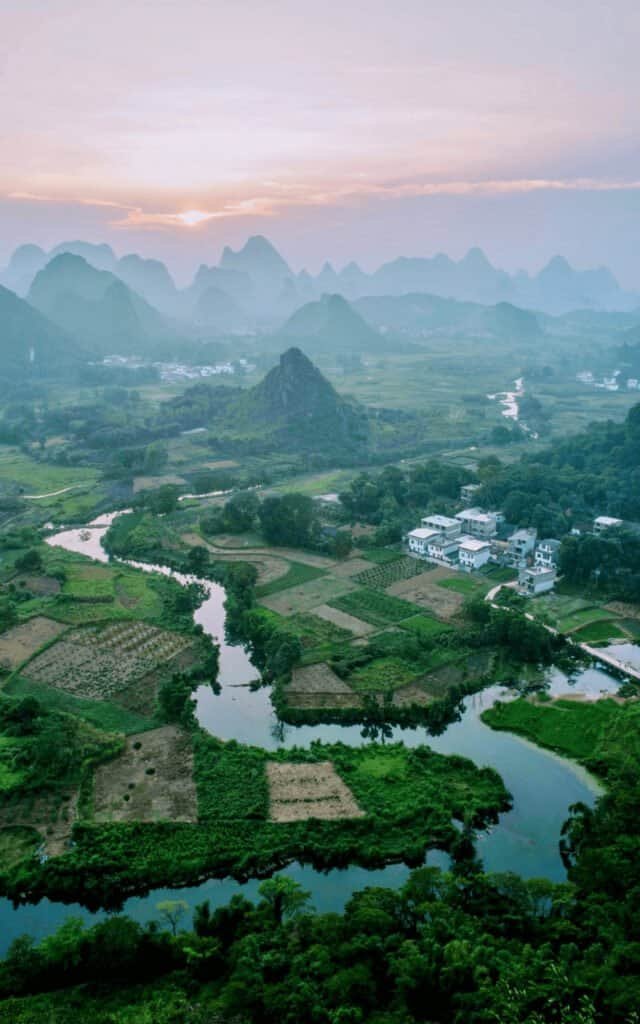
The food scene is also a highlight of the area, with specialties like rice noodles and beer fish that are well-loved across China. And beyond the postcard views, this area gives you a taste of rural life, with fishing villages, minority communities, and late-night local markets that stay busy until long after sunset.
If you’re looking for something slower, more authentic, and deeply rooted in nature, Guilin might be your favorite stop.
Tickets & Tours in Guilin
Day 11: From Guilin to Yangshuo By Ferry
Li River Cruise
After breakfast, on our first day in Guilin, our guide took us to the ferry point for the Li River cruise — three hours of drifting through beautiful karst scenery.
Book early if you can, and hope for clear skies — the karst hills look especially magical in the morning light. While the cruise lasts about three hours, the most stunning formations appear after the first hour, and they’re absolutely worth the wait.
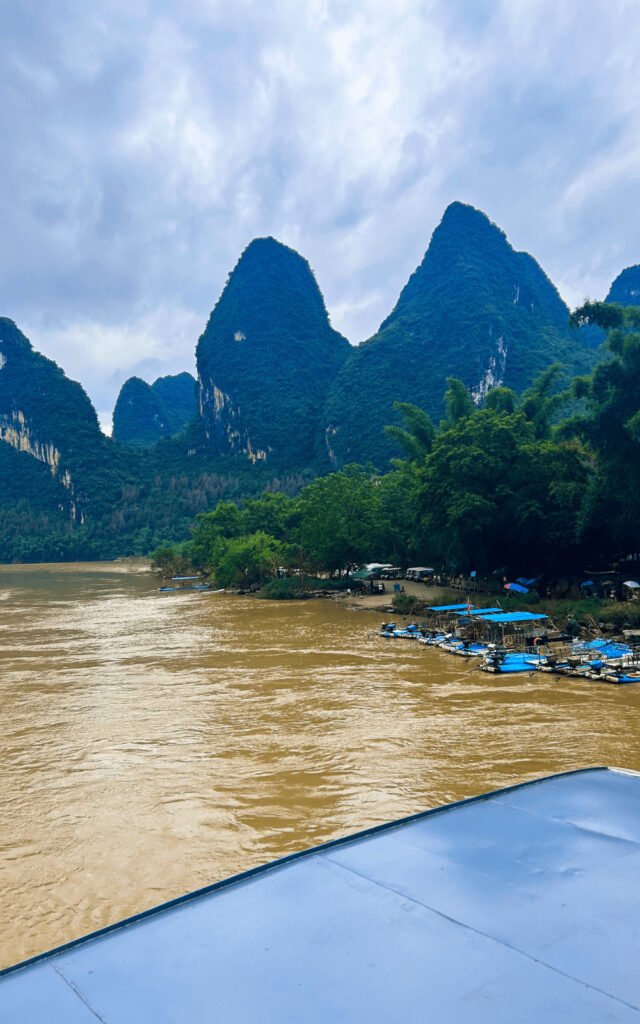
I spent most of the ride on the open deck, soaking in the views — misty peaks, tiny rural villages, and the iconic fishing boats you see across Southeast Asia. Before we knew it, we’d arrived in Yangshuo, a small village nestled between the hills that somehow manages to be both touristy and charming.
Yangshuo
We grabbed lunch right away (I don’t remember the name of the restaurant, but it was close to the Starbucks on the riverside), then wandered around West Street, packed with souvenir shops, fabrics, and all kinds of local goods. You’ll even spot a few expats running their own little businesses.


But the real magic of Yangshuo isn’t the town itself — it’s what surrounds it, towering karst peaks in every direction. If you’re looking for something to eat, try the stir-fried meat with upu taro (like potato, but better), the famous beer fish, or just indulge in a big bowl of rice noodles — pure comfort food!
Once in Yangshuo, you’ve got three main options:
- Head back to Guilin: This is what we did. Just keep in mind that you’ll need to arrange your own return transport. The easiest way is to take a local bus from Yangshuo Station to Guilin South — the ride takes about an hour.
- Stay in Yangshuo: A great choice if you want to explore more of the area. If you’re up for it, you can also plan a hike to Xianggong Mountain the following morning. There’s no public bus to get there, but you can either take a taxi or ask your hotel to organize transport for you.
- Go straight to Xianggong Mountain – If you’re planning to catch the sunrise, this is your best option. Find a place to stay nearby and head out early the next morning to watch one of the most breathtaking sunrises over the karst hills and river landscape. It’s totally worth it.
Day 12: Karst Landscape & Guilin Sightseeing
Xianggong Mountain
Xianggong Mountain is where you can catch the sunrise, casting pink and orange hues on the Li River winding through the karst hills. Because if there’s anything better than being on the river, it’s the view from the top.
The hike is relatively short, taking only about 15-20 minutes to reach the top via safe, easy-to-climb stairs. Of course, this isn’t an off-the-beaten-path location; it’s a well-known photographer’s paradise. There’s an entry fee of around 80 CNY, well worth it for the views.
If you’re planning to head to Xianggong Mountain on your own, check out my Guilin Travel Guide — I’ve included where to stay and how to get to the viewpoint (and how to go back to Guilin). On the other hand, if you don’t want to handle the hiking plan yourself and DIY planning is not your thing, this is a great sunrise tour of Xianggong Mountain.
Guilin Sightseeing
By late afternoon, it was time for us to make our way back to Guilin. The easiest and most hassle-free option is to ask your hotel in Yangshuo (or near Xianggong Mountain) to book a taxi for you.


Mention it when you check in so they can arrange it ahead of time — transportation in that area isn’t always quick to find. The ride takes about an hour, and once you’re back in Guilin, you’ll still have time to explore a few highlights:
- Rong Hu area, where a peaceful lake setting becomes the backdrop for locals practicing tai chi or dancing beneath old banyan trees.
- Shanhu Lake, home to the Moon and Sun Pagodas, is magical when lit up after dark.
- Zhengyang Walking Street is a lively mix of street food, shops, and restaurants. It’s got that classic Asian vibe and is the perfect spot to grab dinner.
- Elephant Trunk Hill, Guilin’s most iconic natural landmark, is shaped like an elephant dipping its trunk into the water.
Day 14: Longji Rice Terraces & Zhuang Village
On our third day, we made our way to the Longji Rice Terraces — one of southern China’s true natural wonders.
The view changes with the seasons, and during the rainy months, the mist and puddles added a moody, suggestive feel. Sure, I would’ve loved the greens of spring or the golden glow of harvest, but the rain gave the whole place a unique vibe (even if I did wish it would let up for a few minutes!).


Beyond the views, the terraces are a testament to the incredible work of the Zhuang and Yao people, two minority groups that have inhabited this area for centuries. We stopped for lunch at a tiny family-run guesthouse in a nearby village — the owner cooked homemade dishes just for us and a couple of Japanese travelers.
The nearby Zhuang Village, with its traditional wooden homes, perfectly represents Chinese rural life — I still remember seeing an old lady washing clothes by hand outside her house. If you’re not visiting during the rainy season, consider hiking the terraces for even more spectacular views.
After lunch, we hopped back in the van and returned to Guilin. It was time for us to catch a train to our last stop: Guangzhou!
If you’re looking for more travel tips (where to stay or how to get around in Guilin), take a look at my Guilin travel guide.
Guangzhou: History, Modernity & Unexpected Beauty
Guangzhou was the last city of the 14-days China tour, and to be honest, after experiencing the energy of Shanghai, I wasn’t expecting much. It was more of a practical choice—it made sense to fly back to Italy from there. But Guangzhou surprised me in the best way.
This vibrant southern city is very different from Shanghai up north. It felt more laid-back, and I noticed far more expats and tourists than I expected. While it’s known as a modern trade hub, it also offers historical sites, peaceful Buddhist temples, and lush green parks perfect for strolling.


Of course, you can’t talk about Guangzhou without mentioning the food. The cuisine from this region is what many people know as “Chinese food” in the West. Tasting local specialties here is an absolute must.
I visited in early July, and let me tell you… the heat was intense. The kind of heat that makes you want to find refuge in massive, ultra-air-conditioned shopping malls—so cold inside you actually need a sweater! Still, despite the humidity, Guangzhou was a beautiful end to the trip and a lovely southern contrast to China’s big northern cities.
Tickets & Tours in Guangzhou
Day 14: History & Sightseeing
Chen Clan Academy
Our first stop of the morning was the Chen Clan Ancestral Hall, a beautiful complex of 19 buildings with nine halls and six courtyards. Built during the Qing Dynasty by the Chen family, it originally served as both a temple for ancestor worship and an academy to prepare clansmen for the imperial exams.
What struck me the most was the architecture — a perfect balance between charming courtyards and richly decorated inner halls.


Every corner is a piece of art, from intricate carvings and pottery to delicate ivory sculptures. It’s no surprise that today the complex hosts the Guangdong Folk Art Museum, where craftsmanship truly takes center stage.
If you’re visiting without a guide, I highly recommend researching the site beforehand and taking your time to explore each hall (in that case, you can purchase tickets on site). However, if you’d prefer a more in-depth experience, this 1.5-hour private guided tour is a good option to learn more about the history and details behind each masterpiece.
Sun Yat Sen Memorial Hall
If you’re into Chinese history and planning to visit this site, keep in mind that all the signs are in Chinese, so if you want to understand the background and stories behind it, having a guide is pretty much essential. Trust me…I’ve been there without a guide, and it was pretty much useless.
This top-rated half-day Viator tour is a great option if you want to explore Guangzhou with a local guide who can help you navigate both the city and its stories. It covers several key sights I mention in this guide, including the Chen Clan Academy, the Temple of the Six Banyan Trees, the charming Lizhiwan Canal area, and the traditional Qingping Market.

This landmark is dedicated to Dr. Sun Yat-sen, known as the father of modern China, and honors him as the man who led the movement that ended imperial rule and laid the foundation for the republic.
Inside, you’ll find exhibits that walk you through his life, his ideas, and the key role he played in shaping the country’s future. It’s a powerful piece of modern Chinese history, and worth the time.
Temple of The Six Banyan Trees
This was hands down my favorite spot in Guangzhou. Tucked near the Sun Yat-sen Mausoleum (and free to enter), this small Buddhist temple offers a peaceful break from the city. Here, you might easily see monks walking around, chatting with visitors, or quietly praying.


At its center stands the beautiful Flower Pagoda, a rare architectural blend of ancient Indian and traditional Chinese styles. Inside, you’ll find various Buddha statues in different shapes and sizes.
Right outside, there’s a quiet garden space filled with flowers (so many frangipani trees!) and greenery — and when I visited, even a tiny local crafts market. It’s the perfect spot to slow down and reconnect after two packed weeks of travel.
Huacheng Square
Huacheng Square is probably the largest — and most beautiful — square in Guangzhou. But don’t expect a chaotic intersection full of noise. Instead, you’ll find a peaceful park surrounded by the city’s tallest skyscrapers, with shaded paths, bridges, and even an artificial river. It’s the perfect place to stroll and escape the intense southern sun under some of the highest trees.


Nearby, we stumbled upon a charming little restaurant tucked away down a quiet, dead-end street just past Tiyuxi Cross Street, heading toward the square. The food was delicious, and the staff couldn’t have been kinder — they even spoke a few words of English, which was a surprise.
Shamian Island
Shamian Island shows a completely different side of Guangzhou… honestly, it doesn’t even feel like China. Once a foreign concession, this small island is full of colonial-era buildings that look more European than anything else you’ll find in the city.


It’s no surprise that Chinese influencers and international models often come here to snap photos in front of the European-style facades. Even the cafés and restaurants don’t follow the usual Chinese aesthetic — it genuinely feels like you’ve been dropped into a quiet corner of London.
But then you reach the riverside, and the local energy hits you again. This is where the real Guangzhou vibe comes alive: older locals sing, play traditional instruments, dance, and perform for the pure joy of it, while others watch, clap, and join in. It’s such a wholesome scene. It’s the perfect pre-dinner stop!
Guangzhou Tower Area
The Canton Tower is hands down one of Guangzhou’s most iconic sights — and the tallest building in the city. You can spot it from almost anywhere, and it truly lights up the skyline.
But what surprised me was the vibe around it. This area quickly became one of my favorite spots in the city. It’s lively, full of people, and the energy is contagious.


One of the highlights is the white pedestrian bridge that spans both sides of the Pearl River. Yes, it’s usually packed, but standing there, watching the skyline light up as the sun sets, feels a bit surreal.
The city glows, the lights reflect in the water, and for a moment, you feel part of something bigger and just so…alive. It’s the kind of place that gifts you with travel breakthrough moments (or at least it happened for me). I would go there after dinner (as around there aren’t many spots, unless you want to eat in a shopping mall).
Day 15: Parks & Last Minute Shopping
Our last day in China started with a peaceful stroll through Yuexiu Park, one of the largest green spaces in Guangzhou. The park is full of local life and historic landmarks — you’ll spot people practicing Tai Chi, joining group dances, or simply enjoying the calm. It’s also home to the Guangzhou Museum and the famous Five Rams Statue.
After wandering around with an iced coffee in hand, I headed to Beijing Road for some last-minute souvenir shopping. It’s one of the busiest shopping streets in town, lined with restaurants, street food stalls, and plenty of options to spend your final afternoon in the city.
If you’re looking for more ideas, tips on where to stay, or how to get around, check out my Guangzhou Travel Guide.
It’s been quite a journey… literally! But here it is — my take on the best 15-day China travel itinerary for first-timers. Hopefully, this helped you plan your own trip or at least sparked some inspiration. And if you’re after something different or a bit shorter or different, stick around — in the next section, I’m sharing a few quicker itinerary options too.
Other Possible Itineraries
One week China Itinerary: One week isn’t a lot, but it’s definitely enough to get a taste of China’s diversity. This itinerary covers Shanghai, Suzhou, Hangzhou, and Nanjing — four very distinctive cities, all located in neighboring regions.
10 Day China Itinerary: If you only have 10 days, I recommend following this route with a stop in Chengdu — or, if you prefer nature over history, you could skip Xi’an and spend a couple more days exploring the stunning landscapes around the Chengdu area. This option takes you through Shanghai, Beijing, Chengdu, Leshan, and Emei Mountain for a mix of city life, culture, and nature.
Off-The-Beaten-Path China Itinerary: If you’ve already visited China and want something a bit more adventurous, start your journey in Xi’an and plan a Silk Road route through the Gansu and Xinjiang regions. This itinerary offers a completely different side of China — from desert landscapes and ancient Buddhist caves to vibrant markets.
Did you find it helpful? 📌 Save it on Pinterest!
